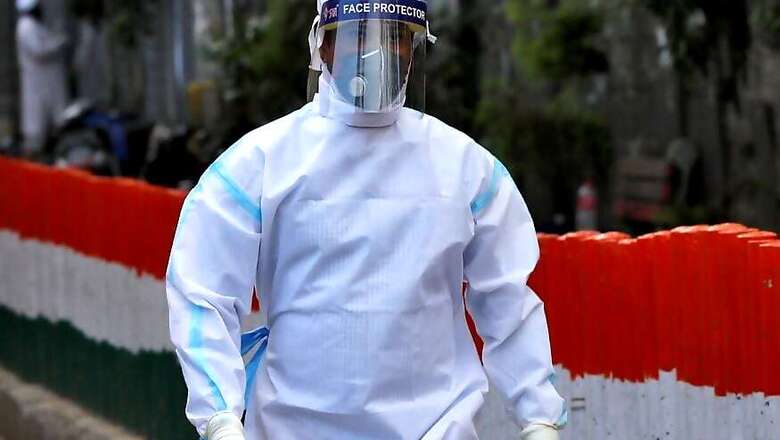
views
India is deep in the fight against the Covid-19 pandemic on multiple fronts — medical, social, economic and psychological. Still a lot of uncertainty surrounds the current situation. The future, by its very nature, stays uncertain.
Minds are understandably in turmoil, seeking answers to many questions — the course of the pandemic, survival, livelihood security, direction of economy, correct strategies, and, philosophically, the unethical past impacting the future of humanity.
Potential strategies for India to combat the pandemic were suggested in my previous article. [Read Here]
This paper stays away from value judgments and attempts to offer answers to some questions based on empirical research, scientific evidence, strategies that have worked against the pandemic and mathematical projections on the course of the disease and its impact on the economy. Potential post-lockdown strategies to ease back into business-as-usual are forwarded as well. Let’s look at:
Where is India at in its fight against Covid-19?
Where is the Covid-19 at in its fight against humanity?
Where is science at in its fight against Covid-19?
Where is the world at in its fight against Covid-19?
What after lockdown?
SitRep India
Over 1,300 cases and 35 deaths on date of filing article
An app developed by author gives real time status of Covid-19 cases of Indian states and some selected countries with easy to interpret graphs-http://covid19-analysis.herokuapp.com/

The app allows for a quick real-time look at state wise figures and those of some selected countries


An unprecedented onslaught, medical, social and financial, is being mounted by India to stay ahead of the pandemic.
How do people of India feel about the disease and governmental interventions?
To find out, a telephonic survey instituted by author in villages and semi-urban areas in UP, Bihar and Odisha of 54 random subjects showed people are aware, support the lockdown and are satisfied with steps taken by government for helping them in the lockdown.
Survey Findings:
Awareness: 11 people know it spread through close contact, 14 said it was a Mahamari (pandemic), 5 attributed it to China. 10 said India shall win the war against Covid-19 and 5 gave definite date from Navratri to 6 months for this to be over. Only 4 respondents were aware but defined it as doomsday. All others were positive about the disease being limited and recovery being certain. All respondents were aware of the pandemic and the seriousness of it, and endorsed the steps taken by government as necessary.
Lockdown: 100% respondents stood with the government on lockdown deeming it as essential to control the pandemic. 3 said it was not properly enforced, 5 said people were not taking it seriously but must, and only one said it should not continue beyond 14 April 2020.
Problems during lockdown: 39 respondents were fully satisfied with the facilities provided including ration. 4 complained about Police beatings, 3 were concerned about outsiders coming in from cities and advised they must be given facilities at border itself and not allowed to come in, 3 demanded for ration, and treatment with one demanding for testing to be made available to villages. One showed concern about livelihood and requested for adequate steps to help the economy. Two wanted relaxation for medicines while one another wanted stricter enforcement.
People in Odisha are particularly appreciative about construction of a new 1000 bed hospital for Covid-19 treatment in record 15 days.
Fig: Telephonic survey of 54 respondents in Rural and semi-urban areas: UP, Bihar, Odisha
What is notable is that 99% people specifically appreciated Prime Minister Mr. Modi for provision of three categories of ration and said they were with him in all his decisions. There was no question in survey about this, just about pandemic, lockdown and their effects.
Urban sentiment:

Sentiment Analysis of tweets carrying lockdown from the time of announcement shows sentiment has stayed positive, and today come to neutral. People are largely receptive to announcement of lockdown and keeping their spirits up.

Fig: Sentiment analysis of tweets carrying lockdown after announcement
From the time of announcement of lockdown, the negative sentiment has come down. Presumably due to confidence generated by announcement of lockdown showing that government is working actively to control the disease. Positive sentiment has also conceded to current sentiment being largely neutral as shown in following graph.
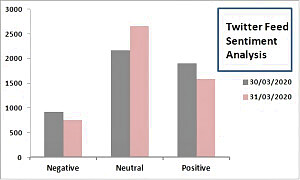
Fig: Change in sentiment post enforcement of lockdown [Source: Author]
MEDICAL TAI CHI: INDIA
Reports say a cheap and fast testing kit (Results in two and half hours) is now made available which can test 100 samples and costs 1,200 rupees ($16; £13) - that's about a quarter of the 4,500 rupees that India pays to import Covid-19 testing kits from abroad.
There are 29 private laboratory chains, accredited by the Indian Council of Medical Research (ICMR) for conducting tests for novel coronavirus as per government. These labs have 16,000 collection centres across the country, where at least 12,000 tests can be conducted per day. Besides private labs, there are 119 government laboratories approved by ICMR, of which 104 are operational for testing Covid-19 and 15 are in the process of being functional according to ICMR data put out on March 24.
India has earmarked 14000 existing ventilators for use of Covid-19 cases, is sourcing 10000 ventilators from China and has instructed India Inc to produce 40000 more speedily. Lakhs of PPE kits and N-95 masks are being manufactured and imported for use and building stock. Special Covid-19 hospitals are being opened, and isolation beds are being added.
What we must is enhance our health budget much much upwards for all times to come.
MEDICAL TAI CHI: WORLD
Some countries have flattened the curve and offer a lot in terms of learning to us. Some countries like US are still struggling to get the pandemic in control. We have been lucky in terms of preparation time and being able to learn from the experience of others without much cost to us.
US has started wide-spread public screening even for mild symptomatic cases. Public is told, “If you have symptoms such as feeling feverish or having a measured temperature greater than 100.0°F OR you have a cough, shortness of breath or sore throat, it’s important for you to be screened for testing.”
New methods for sterilization and decontamination have been discovered. (Re-wear)
Instant tests are now available, both presumptive and confirmatory.
Home testing kits are now being made available in UK. This has the potential to upend the threat of the virus and free the people to go about their businesses as usual.
[Quick Test]
[10 minute test]
[All about Covid-19 testing]
CDC provides anecdotal evidence on successful use of some drugs while awaiting outcomes on clinical trials.
Government of India has approved use of one of these, Hydroxychloroquine for prophylaxis (prevention) among high risk patients and medical professionals. This drug carries risk of toxicity and severe side effects, so the people are strictly cautioned against its use without proper medical advice and prescription.
[Latest Research Covid-19]
Results of therapeutic trials from Spain and Norway are expected soon.
Vaccine is still a year away.
ECONOMIC TAEKWONDO: INDIA
Starting with India, a complete nationwide lockdown is in place till April 14.
Indian stock markets have flung downwards wiping huge swathes of wealth.[Source].Markets downturns do not translate directly in slumps in real economy, and we need to observe economic supply and demand dynamics closely to gauge real economic effects of Covid-19 and their duration. Experts are watching the situation closely and so is the government. Ministry of Finance shall have to continue with confidence boosting measure for the rest of the year. [Broad market scenarios]
Ministry of Finance and RBI have announced packages to help citizens tide over the crisis and help buttress the economy.
At Rs 170,000 crore ($23 billion) relief package announced by finance minister is about 0.9% of India’s GDP. My assessment is this has been done Keeping in sight the fact that the poor and the most vulnerable will bear the brunt of the lockdown. The initial round of financial help is aimed at this section of population. Bailouts for industries affected by recession might be in the pipeline as the situation evolves.
Under the package, about 800 million people will get free cereals and cooking gas apart from cash through direct transfers for three months.
Wages have been raised under the Mahatma Gandhi National Rural Employment Act (MGNREGA) while ensuring Rs. 1,000 ex-gratia payment to nearly 30 million poor senior citizens, widows and disabled. States have been asked to use the Building and Construction Workers Welfare Fund to provide relief to construction workers and the first instalment of Rs 2,000 under the Pradhan Mantri Kisan Yojana will be front-loaded to reach 87 million farmers in April.
Provision of Rs 15,000 crore for strengthening healthcare measures is made. Healthcare workers were promised three months’ worth of payments for medical insurance of up to a total of 5 million rupees, or $66,802. This is received very positively among medical fraternity (author being a part) and has bolstered their resolve in fight against Covid-19.
The Reserve Bank of India (RBI) slashed key repo rate by 75 basis points (bps) to 4.4 per cent to bolster the economy in the wake of Covid-19 menace. Taking cue from the RBI, the State Bank of India too has slashed lending and deposit rates.
Help is coming in from private sector, and it is this combined effort that shall see us through the crisis.
ECONOMIC TAEKWONDO: WORLD
Covid-19 continues to spread at a very fast pace and is impacting economies across the world. The International Monetary Fund chief has said the global economy has entered recession and it will be much worse than the financial crisis of 2009. Separately, the UN estimates Covid-19 could cause up to a $2 trillion shortfall in global income.
Looking at China, which has come a full circle in her fight against Covid-19, short term economic forecasts are negative- Economic Indicator (China) Year-over-year Change (Jan-Feb 2020)

Covid-19 generated economic shock is peculiar that it is both supply and demand side. This might structurally damage the economy, retarding the recovery for a long time.
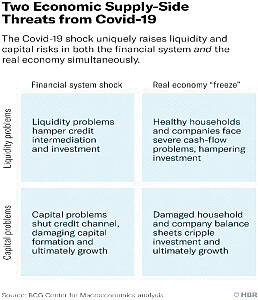
Anticipating adverse effects of pandemic on economy and to help people directly, almost all countries have announced financial and economic packages. For a comparative chart kindly visit this site
POST-LOCKDOWN INTERVENTION AND ECONOMIC RECOVERY
There is a way out, but it demands immense discipline, immense scale of testing and disease surveillance and development of surge capacity medical facilities. Lockdown has bought us time to put in place these measures and we can hope there shall not be a let up by decision makers on any front. Initial realization that it had to be on war footing was palpable and it shall bring us rich rewards in control of both biological and economic contagion.
We shall have to tread with a lot of caution and anticipate unforeseen trajectories, and therefore, response required may be untested and novel as the virus. While learning from history, we must not shy away from innovative solutions and some boldness.
What we must guard against is disruption of credit lines. To prevent economic depression supply lines must be reopened and labour force re-engaged.
Given the scale and outlook of shock, we must not shy away from bailouts, bank recapitalizations and widening fiscal deficits. Easy loans to companies and households with favourable restructuring of repayment and mortgage terms is essential. Cash and credit lines to MSMEs must keep flowing.
Big companies might like to adopt and finance small set up’s like venture capitalists to keep these afloat in the time of crisis.
Government may underwrite these investments on a long-term basis to enable minimize risk to big companies.
Industries which can, must repurpose and make medical equipment to meet urgent requirements.
Google announced $800 million in credits and investments, including $250 million in ad grants to the W.H.O. and other government agencies, and a $200 million investment fund to assist non-profits and lenders with efforts to help small businesses. It’s also working with a supplier to produce two million to three million face masks for the C.D.C. Foundation.
During supply crunch, income inequality and unequal reserve capacities may see a few hoarding the essential items like food and drugs, and the less privileged being denied the access even when ready with cash. Thus, price caps and rationing of essential commodities is required till supply lines are freed and moving.
In the farm sector, states have selectively allowed rabi harvest activities. Mass return of labour shall induce a bump in harvest and supply to markets. (These states must ensure people maintain due physical distance and observe recommended hygiene to stay healthy and prevent spreading the contagion) Mandis must operate, produce must reach the markets (government supply lines) and cash needs to reach people to make purchases. So, we cannot stay in lock-down for prolonged period.
How to fund our efforts?
We have lot of scope of enhancing the financial package as the initial one is just 0.9% of GDP. If the transmission is controlled through testing and discipline, our economy might not get derailed much.
Further we have other means of financing the crisis like borrowing.
India debt to GDP ratio at 69.62 is much lower than USA (107) or Japan (238).
The ratio of India's sovereign external debt to gross domestic product (GDP) is among the lowest in the world - less than 5%. So, we must not shy away from borrowings-both external and internal to finance the crisis. [Source] [DEA, Details, India]
To avoid crowding out of domestic companies from internal sources, government must majorly borrow from overseas.
We need to help others too, as this fight has to be won in all geographies to insulate every population.
LOCKDOWN HAS BOUGHT US TIME
Lockdown minimizes transmission of virus to cub-critical levels where it is no longer a threat for mass spread. It also buys us time to prepare our medical infrastructure in place so that we are ready to tackle resurgences in infection and consequent disease load effectively.
Doctors and ancillary health workers to be given crash courses in respiratory medicine, and operation of sophisticated equipment in ICUs like ventilators, and ECMO Machines. PPE and medical devices must be produced, procured and provided on war footing.
Workplaces may be equipped for social distancing.
Our goal must be to save maximum lives and save lives carrying maximum value.
POST LOCKDOWN: NOT BUSINESS-AS-USUAL
Government has signalled that lockdown shall be lifted after 14 April.
Further planning essentially depends on the course of the virus and not of households and firms. We do have some helpful forecasts here.
In the absence of vaccine or cure, every time we venture out, we are as likely to get infected as in the beginning of pandemic. Therefore, we must stake out to harmonize life with coronavirus pandemic till a vaccine or cure is in hand. WHO says it is at least a year away.
Further, physical isolation does not allow herd immunity to form, so defences stay low. Only defence against the contagion is social distancing, hand washing and cough hygiene.
To keep ahead of the enemy in battle we need information about the enemy. What do we have about Covid-19 and how do we match against it? Let’s examine:
SINE WAVE THEORY: CORONA SHALL KEEPING REVISITING AWHILE
We have seen resurgence of virus in many countries like Singapore and Hong Kong where it was contained.[Resurgence of pandemic]

Fig: Sine Wave of Covid-19 GIF: The crests and troughs are for demonstration only and do not reflect real cycle of disease, which is unknown as of today.
Corona interventions may have to be turned off and on like a spigot[Harvard].It may be necessary to keep having periodic intervals of quarantine until the healthcare system is fortified.
SHOULD WE REOPEN AT ALL?
Researchers at University of Texas at Austin have worked out plausible scenarios for effectiveness of different levels of intervention on disease load on health care facilities.
Escalating severity of social distancing greatly reduces Covid-19 load on health care facilities. Level for different localities may be worked out given the status of risk for the locality. Using US Covid-19 Pandemic Model and following assumptions and parameters (Starting condition: March 23, 2020 with 84 infected adults and 18 infected children, Epidemic doubling time: 4 days, Reproduction number: 2.2, Average incubation period: 7.1 days, Proportion of cases asymptomatic: 17.9%), they forecast scenarios under no intervention, school closures, school closures with 50,70 and 90% social distancing.(See source for details)
The red line projects Covid-19 transmission assuming no interventions. The blue lines show increasing levels of social distancing interventions, from light to dark: school closures plus social distancing interventions that reduce non-household contacts by either 50%, 75% or 90%. Lines and shading indicate the median value and interquartile range across 100 stochastic simulations.
Let’s look at projections:

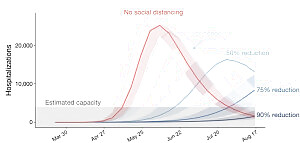
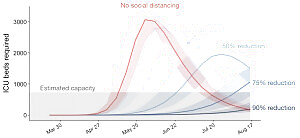

We can clearly see that social distancing measures adopted early during disease reduce incidence of infections as well as requirements of medical facilities considerably. This mantra is being repeated on a loop by all agencies, experts and is borne by evidence so far. We must never lose sight of this even momentarily and let our guard down or be complacent about it till we get a vaccine or cure given sine wave nature of Covid-19.
OUR ADVANTAGE
We went into lockdown at a very early stage of pandemic spread. This pre-emptive strike is likely to bring us rich dividends in stopping the community transmission, mitigating the disease load to manageable levels and saving our economy. Australia and New Zealand have locked down early too citing our example.
Indian demographics afford us considerable strength against Covid-19. Studies indicate Indian weather may also slow down the spread in ensuing summer.
Studies indicate countries can modulate their response to Covid-19 based on their demography. [Demographics and Covid-19 response]
It says the lower than expected number of cases detected in Africa (despite extensive trade and travel links with China), suggests that the young age structure of the continent may be protective of severe and thus detectable cases, or it may be undetected. Beyond age structure, there are large sex differences in mortality that need to be understood – with men at higher risk – some of which may be accounted for by the stark differences in smoking rates by sex in Asia. Distributions of underlying comorbidities such as diabetes, hypertension and COPD will likewise refine risk estimates.
1. Overall case fatality rate for India is low compared to the world.
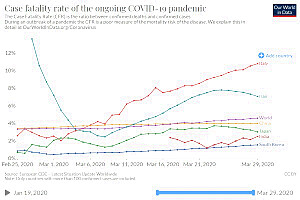
2. Age specific Covid-19 mortality

We are a young nation

3. Covid-19 Fatality Rate with comorbidity

How do we fare here?

Disease statistics and demographics suggest we may relatively safely come out of lockdown. The old (>60), the very young (<5) and those with any disease stay at home till a vaccine or cure is found. Rest of us can go to work while maintain social distance. I reiterate here-in no condition, we can underestimate the threat of Covid-19, we open up after having placed adequate testing and treatment facilities in place, robust risk assessment through data collection and surveillance, risk based ranking of districts and cities, selective and cyclical closures, and working from home where possible.
POST-LOCKDOWN STRATEGY
• Only panacea against prolonged lockdown and for reassuming economic activity is mass testing. [Researchers for mass testing]. Lockdowns should be guided by testing and serological survey data and should be planned on a rolling basis.
• We must categorize districts and cities as High, Medium and Low risk through strict data collection, surveillance and assessment.
• Lockdown and stay-at-home directives must be stratified depending on local risk assessment. Workplaces, schools and localities are to be opened in phases.
In India, the risk assessment must consider understanding clinical course in the Indian context, viral shedding (both nasopharyngeal and stool—which is documented, and a particular concern in the south Asian context), paediatric illness in the context of malnourished children. In the data from China of about 2000 children with Covid indicated that 20-30% (including those 1-5 years old) do have severe or critical illness. The total number of kids is small compared to the total; but children can get sick and are at greater risk in India. [Banerjee & Duflo]
Selective closures may be ordered as circuit breakers based on risk assessment.
• We need detailed and systematic data collection including state level needs for bed capacity, oxygen flow masks and tanks and ventilators.
• We need to focus on both children under the age of five and the elderly. Early testing and healthcare in this population could help significantly reduce the mortality toll of the epidemic. We should be prepared for multiple peaks in the model (we have only shown what happens in July) and we should be prepared for more cases and deaths later in the year. Keep elderly, children under 5 and those with pre-existing medical conditions isolated.
• Like China, Japan and South Korea, everyone may wear a mask while out. But, the use of a mask alone is not enough to stop infections and must be combined with frequent hand washing, covering sneezes and coughs, and avoiding close contact with anyone with cold or flu-like symptoms (coughing, sneezing, fever). CDC has advised use of cloth masks which can be easily sterilized for reuse.
To clean these masks for reuse two methods are shown to be effective in non-hospital settings
a. 70 C / 158 F heating in a kitchen-type of oven for 30 min
b. hot water vapour from boiling water for 10 min
(Decontaminate masks)
• Open workplaces where strict social distancing and provision of protective gear is possible. We must find stability in production of goods and services within existing conditions- new normal till vaccine, treatment or herd immunity become available.
• Diversify production in areas with low transmission rates and safe pockets.
• There must be no letup in efforts to put in place health facilities to meet surge capacities, discovery of vaccine and drugs.
• Presumptive quick testing with infrared temperature checking may allow us to open flying. It might be more cost effective and open supply routes. Non-essential travel stays banned.
• All activities must accompany social distancing and good hygienic practices. [Social Distancing-What & How?]
• Risk communication by the highest sources in the government to sustain confidence, allay fears and counter rumours.
• Repurpose biotech labs for mass production of Covid-19 vaccine as and when it is launched to meet our requirements.
Since testing is the way out of our houses and normalization of life, it requires a detailed look.
We need a two-step testing strategy for all post lockdown:
1) Presumptive screening tests
Deploy rapid serological immunoassay testing kits just like pregnancy tests for presumptive diagnosis. Procure home use kits in bulk.
Screening tests must have high sensitivity i.e. false positives (person does not have disease, but test is positive) are allowed but not a single false negative (person has disease, but test is negative). We can afford people staying at home and retested in formal laboratory settings at the expense of some anxiety but with minimum danger to community. However, a single carrier let loose in the community can cause havoc, leading to explosive consequences like patient 31.
In addition to identifying people with Covid-19, it could tell you if someone was once infected but then recovered, freeing up her resource for work.
South Korea won the fight through surveillance testing. China has reopened quickly and is testing in schools and factory gates before every shift. High risk areas remain closed in both.
2) Confirmatory tests:
Those found positive in screening tests need to be formally tested with RT-PCR confirmatory tests, and isolated and treated as per protocol. Their contacts need to go in quarantine for due period.
We are not testing enough currently, and post lockdown transmission cannot be controlled without mass testing.

LOCAL LEVEL MUAY THAI
Here I offer just a couple of practical suggestions to smooth wrinkles in delivery.
While working as a District Magistrate, I recall GFR restrictions on Petroleum and Diesel put restrictions on mobility of district administration. This cannot be allowed to happen in the current crisis. Reliance industries has promised free fuel for emergency vehicles. District administration vehicles may be brought under coverage too.
Provision of ready to eat dry meals for old, school going children and Anganwadi beneficiaries to ensure food security while observing social distancing. We have immense resources and scientifically vetted nutritious meal choices. Ensure enough redundancy in stocks so that no one dies of hunger.
ASHA and ANMs must be trained for presumptive identification of symptoms and referral for testing. They may be authorized to order quarantine.
The battle is long and dreary but win we must
Covid-19 has ricocheted us back to tribalism, entire humanity has risen as a single front against common enemy. G-20 met and gave a call for Fight, Unite and Ignite- to unite against the disease for a concerted fight for its annihilation, and ignite the fire of human innovation and ingenuity to keep the economy on its feet. Our prime minister’s advice to the world at G-20 forum to prioritize humanitarian concerns over profit shall be a beacon for future global policy.
There are now more than half a million confirmed cases of Covid-19 and more than 20,000 deaths. These must concern us deeply, but let's also remember that around the world, more than 100,000 people have recovered.
If we are physically fit, we have more than 99% chance of survival after getting corona. Covid-19 does not kill on a mass-scale, lack of critical care is what does us in. It’s not about getting sick; it’s about getting sick in a staggered manner so that we do not overwhelm the hospitals and do not put doctors and medical professionals under risk.
And remember that this pandemic is hurting everyone in different ways—labour losing work, children losing school time, people getting sick and dying. But it hurts the most vulnerable people the worst. People who don’t have access to health facilities, who are in informal sector without registration, who don’t have ready access to internet for home schooling, or who already have weakened immune systems from other issues are bearing the biggest load here. Until governments catch up to helping them out, anything we can do for them is going to be part of the real fight against the disease. So, let’s be generous and help in whatever manner we can. And don’t forget to keep distance.
We shall surely win this fight. Question is when and how with minimal loss to lives and livelihoods. India’s demographic dividend shall pay richly in fight against the pandemic. Nature has made huge concessions for India. We are ordained to survive both biological and economic contagion provided we fight with prudence and with all boots on the ground.
(The author is a doctor and IAS officer who has worked as Special Secretary, Health, Commissioner Food Safety, Drug Controller, and Project Director for HIV/AIDS control for Delhi Government. She is currently doing MSc Economics at University of Texas at Austin. She is certified in Data Analytics from McCombs School of Business.)


















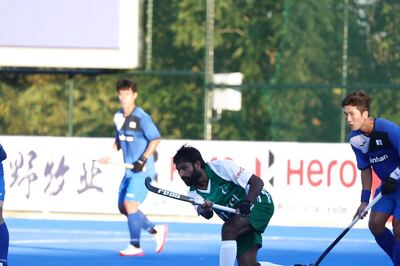

Comments
0 comment